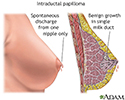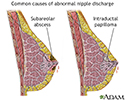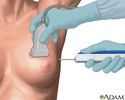Intraductal papilloma
Intraductal papilloma is a small, noncancerous (benign) tumor that grows in a milk duct of the breast.
Intraductal papilloma occurs most often in women ages 35 to 55. The causes and risk factors are unknown.
Symptoms
Symptoms include:
- Breast lump
- Nipple discharge, which may be clear or bloodstained
These findings may be in just one breast or in both breasts.
For the most part, these papillomas do not cause pain.
Exams and Tests
The health care provider might feel a small lump under the nipple, but this lump cannot always be felt. There may be discharge from the nipple. Sometimes, an intraductal papilloma is found on a mammogram or ultrasound, and then diagnosed by a needle biopsy.
If there is a mass or nipple discharge, both mammogram and ultrasound should be performed.
If these are normal, then breast MRI is sometimes recommended. If the MRI is normal, a needle or surgical biopsy may be performed to rule out cancer.
An intraductal papilloma is diagnosed on needle or surgical biopsy.
Treatment
If there is nipple discharge, the duct is removed with surgery if imaging did not show a lump that can be checked with a needle biopsy. If a needle biopsy shows an intraductal papilloma, the papilloma may be removed with surgery, or watched over time with exams and imaging.
Outlook (Prognosis)
For the most part, intraductal papillomas do not appear to increase the risk of developing breast cancer.
The outcome is excellent for people with one papilloma. The risk for cancer may be higher for:
- Women with many papillomas
- Women who get them at an early age
- Women with a family history of cancer
- Women who have abnormal cells in the biopsy
Possible Complications
Complications of surgery can include bleeding, infection, scarring, and anesthesia risks. If the biopsy shows cancer, you may need further surgery and treatment.
When to Contact a Medical Professional
Call your provider if you notice any breast discharge or a breast lump.
Prevention
There is no known way to prevent intraductal papilloma. Breast self-exams and screening mammograms can help detect the disease early.
References
Davidson NE. Breast cancer and benign breast disorders. In: Goldman L, Schafer AI, eds. Goldman-Cecil Medicine. 26th ed. Philadelphia, PA: Elsevier; 2020:chap 188.
Klimberg VS, Hunt KK. Diseases of the breast. In: Townsend CM Jr, Beauchamp RD, Evers BM, Mattox KL, eds. Sabiston Textbook of Surgery. 21st ed. Philadelphia, PA: Elsevier; 2022:chap 35.
Sasaki J, Geletzke, Kass RB, Klimberg VS, et al. Etiology and management of benign breast disease. In: Bland KI, Copeland EM, Klimberg VS, Gradishar WJ, eds. The Breast: Comprehensive Management of Benign and Malignant Disorders. 5th ed. Philadelphia, PA: Elsevier; 2018:chap 5.
Intraductal papilloma - illustration
Intraductal papilloma
illustration
Abnormal discharge from the nipple - illustration
Abnormal discharge from the nipple
illustration
Core needle biopsy of the breast - illustration
Core needle biopsy of the breast
illustration
Review Date: 11/6/2021
Reviewed By: Debra G. Wechter, MD, FACS, General Surgery Practice Specializing in Breast Cancer, Virginia Mason Medical Center, Seattle, WA. Also reviewed by David Zieve, MD, MHA, Medical Director, Brenda Conaway, Editorial Director, and the A.D.A.M. Editorial team.





